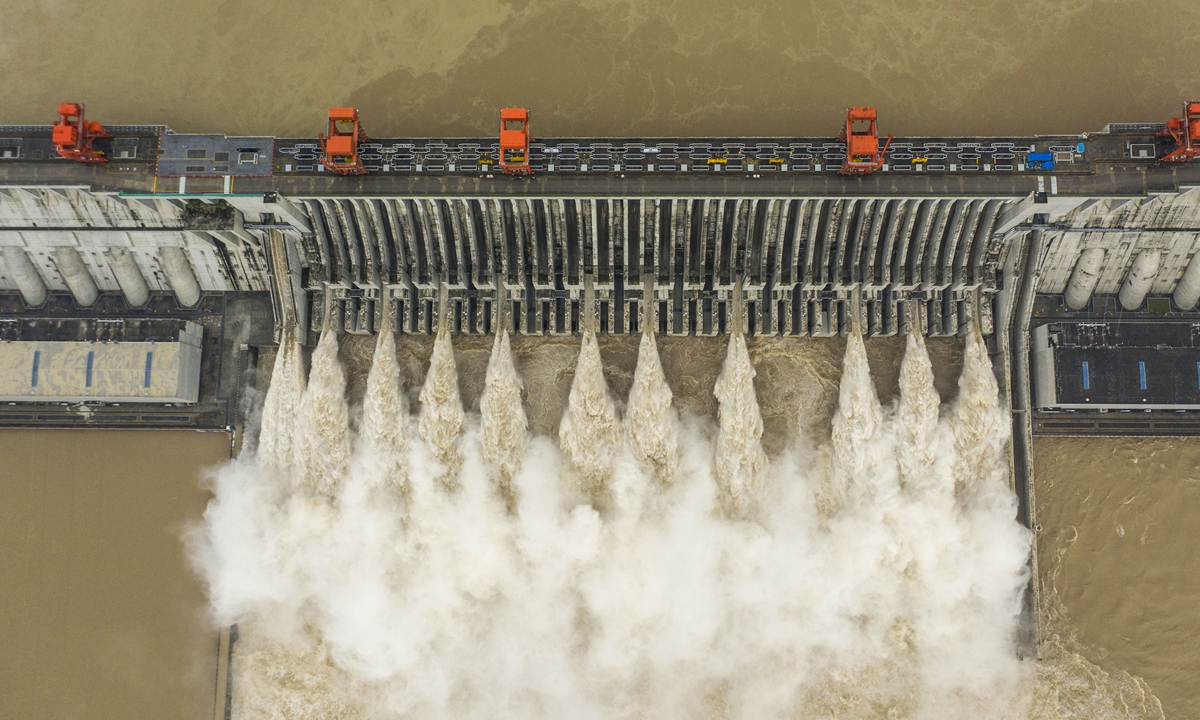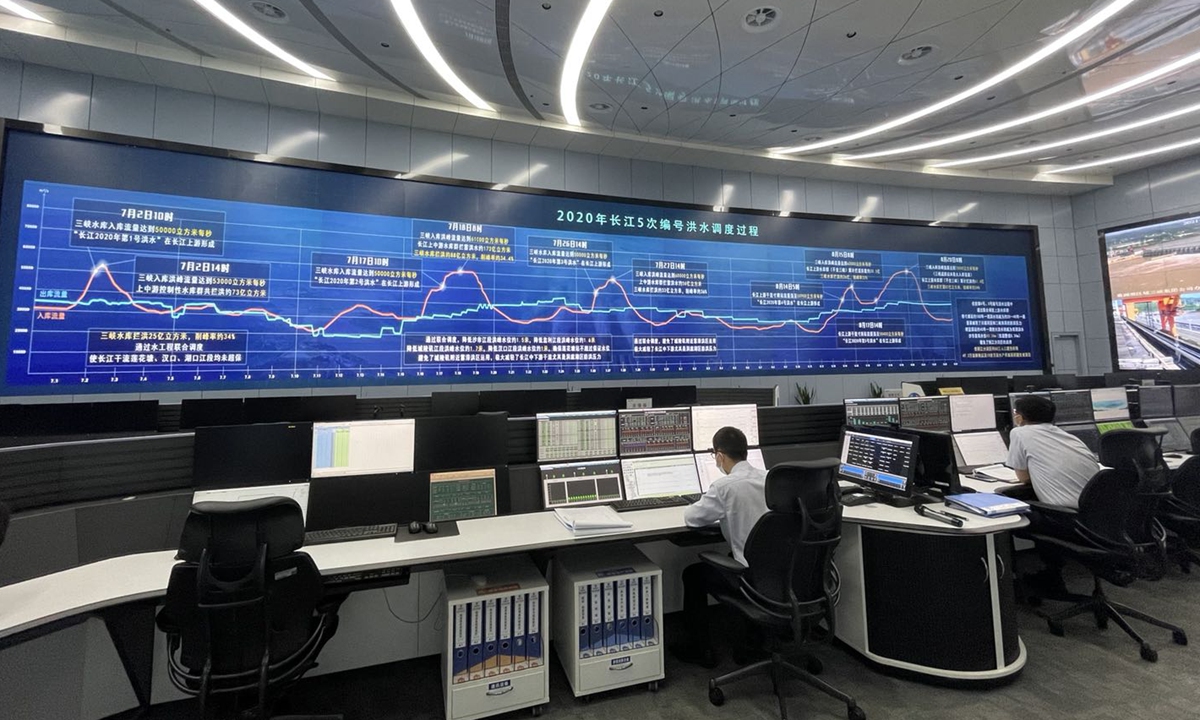
The Three Gorges Dam in Yichang, Central China's Hubei Province, opens 11 release valves to discharge water on August 20, 2020, to cope with the biggest flood since the construction of the dam. Photo: VCG
Since the beginning of the height of the rainy season in July, frequent flooding across China has continued to tug at the heartstrings of all Chinese people. In the face of severe flooding caused by record-breaking heavy rainfall in northern China, especially flash floods in Henan Province, major water conservancy projects along the Yangtze River in the south also put in place measures for flood control, and dam operators have been constantly on alert for possible sudden flood hazards.
Engineers and experts told the Global Times said that the dams built along the Yangtze River have all passed various tests and been playing a key role in combating seasonal floods. Despite the relatively low rainfall in the Yangtze basin this year, these cascade reservoirs have been a source of security for the life and property of people living along the river.

A robot inspects a 220kV GIS switchyard equipment at the Gezhouba Dam. Photo: Ma Yunyan/Three Gorges Corporation
Joint operation of 47 dams
According to China Three Gorges Corporation (CTG), in mid-July, the upper stream and tributaries of the Yangtze River experienced persistent heavy rainfall. Faced with two consecutive floods delivering over 40,000 cubic meters of water per second, the Three Gorges Dam, the world's largest hydropower project, freed up 1.284 billion cubic meters of reservoir capacity in advance, controlling the discharge flow at about 31,300 cubic meters per second, cutting the peak rate by about 30 percent.
"The Three Gorges Dam has changed the flood control across the Jingjiang reach of the Yangtze River, raising its flood control standard from once in 10 or 20 years to once in a hundred years," Li Shuai, senior engineer at Hub Operation and Management Center of Three Gorges Dam, told the Global Times.
In 2020, the Yangtze River experienced several rounds of heavy flooding. The Three Gorges Dam opened 11 spillway tunnels and successfully confronted the largest-ever flood peak of 75,000 cubic meters per second, finally containing a total of 29.5 billion cubic meters of water, accounting for about 60 percent of the total floods prevented in the upper and middle reaches of the Yangtze.
Data shows that from 2003 to 2020, the Three Gorges Reservoir has been filled 61 times to prevent floods, among which three times were to contain mega-floods of more than 70,000 cubic meters per second.
Experts point out that in addition to the fully operational Three Gorges Dam, the cascade reservoir group in the upper reaches of the Yangtze River has also assumed a vital task in resisting the threat of flooding.
In June, China's Ministry of Water Resources approved a conjunctive management plan saying that during this year's flood season, a total of 47 dams along the Yangtze River will be jointly operated for flood control and power generation purposes, with a total flood control storage capacity of 69.5 billion cubic meters. Among them, there are seven dams are under the jurisdiction management of the CTG, with a total regulating reservoir capacity of 47.3 billion cubic meters and 38.6 billion cubic meters flood control reservoir capacity, playing a key role in the flood control system of the Yangtze River Basin.
The Wudongde Reservoir on the upper Yangtze River, which came into full operation in June, is already capable of assisting in flood prevention, and the joint flood control operations will be carried out with its downstream reservoirs such as Baihetan, Xiluodu and Xiangjiaba to improve flood control standards in the Sichuan-Chongqing reach of the Yangtze, in combination with the Three Gorges Reservoir to hold back floodwaters in the middle and lower reaches of the river system, Li said. "In the Yangtze River basin, there are 1,400 weather stations and more than 20,000 hydro-meteorological stations established for providing most real-time, accurate and comprehensive information for reservoirs' safe operation," a representative from the Three Gorges Cascade Dispatch and Communication Center told the Global Times.
The same representative noted that with technical support offered by the BeiDou Satellite Navigation System, the most advanced weather measurement equipment currently adopted by the CTG can issue and update refined weather forecasts every 10 minutes, and can accurately predict the precipitation situation of the entire Yangtze River basin within 10 days on a grid basis management.
"This precipitation and hydrological forecasting system divides upstream areas into more than 130 monitoring sections to measure the runoff into reservoirs through amount of precipitation, and on this basis to make a seven-day rolling operation plan for the terrace reservoir, with the forecast accuracy reaching 98 percent within 24 hours and 92 percent within one week," he added.
At present, CTG is gradually strengthening inspection procedures for key equipment built into telemetry stations, and increasing the frequency of communication and information sharing with local governments in each reservoir area to ensure a rapid response to special and emergency situations.
The Chinese government and many hydropower engineering companies have made an enormous effort to combat flooding, and over the years in a constant struggle against the forces of nature, Chinese people have become more humble, rigorous and respectful of science, forming a series of well-tested and regulated operations to deal with almost any contingency, He Wei, a deputy director of the Engineering and Construction Department of Baihetan Hydropower Station, the world's most technically challenging hydropower project under construction, told the Global Times.
"The Yangtze River used to be a river that people couldn't harness, but now, the flood of the Yangtze is no longer a beast but a resource," He said.

A giant screen at the Three Gorges Cascade Dispatch and Communication Center shows the flood peak shaving process. Photo: Lin Xiaoyi/GT
Precaution due to Henan floods
The Global Times learned that after the torrential rains and floods that have killed at least 302 people and caused massive loss in Central China's Henan Province, operation and management teams of various water conservancy projects in China have been implementing a more disciplined approach to ensure safe operations. "The failure of some dams during the flood in Henan sounded an alarm for us," Xiang Ke, deputy director of the Gezhouba Hydropower Plant, told the Global Times.
Xiang pointed out that before the arrival of the flood season in July, the CTG has organized flood control coordination meetings for the Three Gorges-Gezhouba Dam gradient hub, developed a new edition of flood control workbook, and carried out targeted inspections of key parts and equipment of the dam, strengthening flood control material reserves and emergency drills.
"With the establishment of the upper Yangtze River reservoir group, the pressure of flood control in the basin is being gradually reduced, but responding to local sudden disaster weather is still the focus and difficulty of our work," Xiang said, noting that some dams in Henan failed during heavy rains mainly because the fast-rising water seeped through the holes and gaps of the dams.
Currently, the Three Gorges Dam and the Gezhouba Dam have completed the inspection of the dams' holes and downstream barriers, and used the self-developed dredging robots to strengthen the cleaning of floating objects near the dams to avoid damage to power generation and navigation. As of July 29, the Three Gorges Reservoir has cleared around 20,000 cubic meters of floating material in the dam area.
At the same times, in response to Western media outlets' claim that China's extensive construction of the dam triggered extreme weather such as heavy rainfall and drought and may even induce earthquakes, Xiang said that the dam may slightly change the local microclimate across the reservoir area, such as water storage makes the reservoir area more moist, more conducive to the growth of green vegetation, but is unlikely to influence the atmospheric circulation or affect the ecology and climate of the whole region.
"We will proactively respond to critical periods of flood control that typically last until mid-September, ensuring the orderly control of flood storage throughout the cascade reservoirs, in addition to the integration of water resource management and power generation efficiency," Xiang said.






